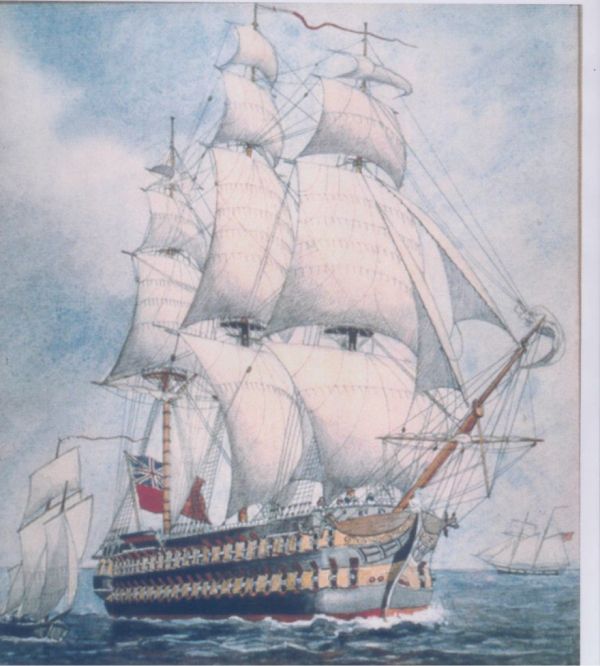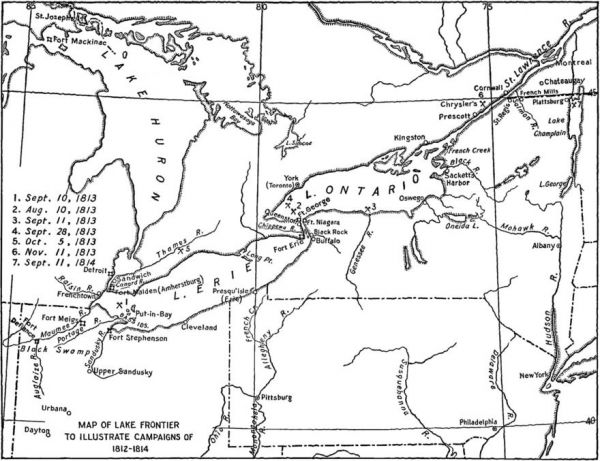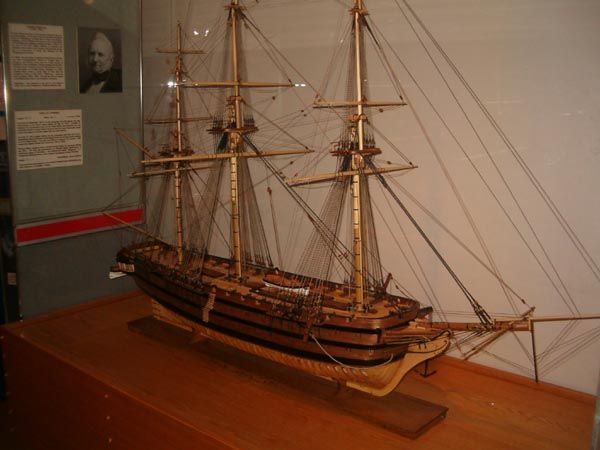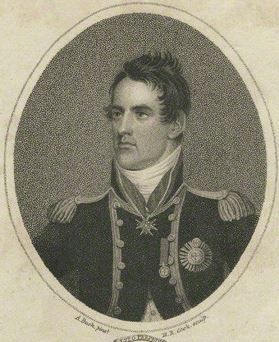
This is painting of HMS St. Lawrence. With 112 guns, it was the largest warship ever seen on the Great Lakes and the largest Royal Navy vessel to ever sail entirely on fresh water.
After Napoleon abdicated, the British government offered the famous Duke of Wellington the command of its forces in North America. For several reasons, Wellington declined. Among them, Wellington stated that what Britain needed in the war against the United States was not a huge army, but naval control over the lakes between the United States in Canada. These waters alone were the highways that could carry British armies into the United States.
 (Map from Mahan's Sea Power and Its Relations to the War of 1812)
(Map from Mahan's Sea Power and Its Relations to the War of 1812)Early in the War of 1812, Britain gained control over Lake Huron. The Americans eventually gained superiority on Lake Erie and Lake Champlain. But Lake Ontario was different and this huge warship is one reason why.
Niagara Falls blocked Lake Ontario from Lake Erie and rapids at the mouth of the Saint Lawrence River limited the size of vessels that could travel from the sea onto Lake Ontario. Thus it was necessary to build large vessels on-site.
 (Model of HMS St. Lawrence at the Hamilton Military Museum. Photo by John R. Grodzinski.)
(Model of HMS St. Lawrence at the Hamilton Military Museum. Photo by John R. Grodzinski.) Commodore
James Lucas Yeo (left), the Royal Navy commander on the Great Lakes,
oversaw construction of a vessel that he thought would ensure British
naval supremacy on Lake Ontario. When finished and fully outfitted, HMS St. Lawrence carried a crew of 837 men and held 112 guns. It was larger than Horatio Nelson’s own HMS Victory.
Commodore
James Lucas Yeo (left), the Royal Navy commander on the Great Lakes,
oversaw construction of a vessel that he thought would ensure British
naval supremacy on Lake Ontario. When finished and fully outfitted, HMS St. Lawrence carried a crew of 837 men and held 112 guns. It was larger than Horatio Nelson’s own HMS Victory.The United States Navy on Lake Ontario had nothing that could possibly counter it.
HMS St. Lawrence launched on September 10, 1814. The next day, the United States defeated the Royal Navy on Lake Champlain. Four days later, it stopped the British attack at Baltimore (which inspired The Star-Spangled Banner). The war was winding down as both sides were exhausted and willing to take peace talks seriously.
Yeo took the St. Lawrence on its maiden voyage on October 16. He considered attacking the naval installation at Sackets Harbor, New York. But it was too late in the year for a sustained offensive, so Yeo shut down the St. Lawrence for the winter. In December, the diplomats signed a peace treaty, ending the war.
The massive HMS St. Lawrence never saw combat. It was promptly decommissioned. In 1831, it was cut down and sunk as a wharf in Kingston harbor.
(Portrait of Yeo by Henry Richard Cook)
Bonus item: one of the American defenders of Sackets Harbor was a teenage soldier named Hiram Cronk. Cronk lived to the age of 105, dying in 1905. He was the last American veteran of the War of 1812.

No comments:
Post a Comment